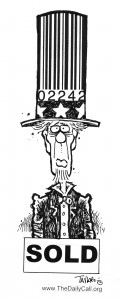There is a disconnect between what indicators say and what workers feel. A hard look at the numbers shows all isn’t well.
By Michael Paarlberg
The Guardian (3/4/16)
Election years produce odd spectacles, like presidential candidates talking about their penises, or normal people talking about Labor Department jobs reports. In saner times, a release of nonfarm payroll data from the Bureau of Labor Statistics (BLS) would attract the level of attention appropriate for, well, nonfarm payroll data from the BLS. But these are not sane times.
With an election season defined by its unpredictability, we can take some comfort in the few predictive rules we have left, like James Carville’s old “the economy, stupid” maxim. Research and common sense indicate a strong economy is good for incumbent parties, so a good jobs report should mean a Democratic victory in November.
Economic voting trends make a report like Friday’s especially crucial because most voters don’t wait until election day to make up their minds; they go with their gut feeling of whether their living standards have been getting better over a period of time. Most political science election forecasting models look at economic trends 6 months before an election. Carville’s maxim, after all, is just a variation of Reagan’s “are you better off than you were four years ago?”
Reagan, like Obama, won reelection handily with unemployment above 7%, but with that rate falling, aggregate income rising, and the general perception that things are getting better.
But there’s still the question “better for whom?” Friday’s jobs report is a mixed bag, with enough positive indicators for the White House to brag about, which ithas. Job growth continues, with 242,000 new jobs created in February. The unemployment rate, holding steady at 4.9%, is undoubtedly healthier than this time four years ago, when it was 8.3%.
Nonparticipation in the labor force, ie people who aren’t counted because they’ve been out of work so long they stop looking, can mask higher real unemployment, so it’s promising that the labor force participation rate rose as well.
At the same time, wages fell, by 0.1%. There’s some evidence that this is a fluke, the result of the survey period ending before the 15 February payday. Over the entire year, wages have risen, by a modest 2.4%, but this is still well below pre-recession rates. So too is the employment-to-population ratio. Job growth is concentrated in the service sector – health care, retail, and restaurants – and especially in part-time employment, which grew by 489,000 compared to 65,000 new full time jobs.
Manufacturing jobs, much touted by the White House as a hallmark of the recovery, are down. Some market analysts take a dim view of unemployment as an indicator: “It is apparent that the UE rate is meaningless, as body count is a worthless metric during a prolonged period of low-quality jobs creation”, Longford Associates’ Joan McCullough told the Wall Street Journal.
Granted, the disappearance of manufacturing is an ongoing historical trend, one that goes mostly unnoticed by those outside of factory towns except in the abstract, economic sense. It’s easy not to mourn “dirty jobs” – certainly no one reads Adam Smith and says “That pin factory job sounds great! Sign me up!” But today, the same workers who could once support a family at that pin factory are now working in retail stores and bars, scrambling to get by on erratic and part time schedules.
Those workers haven’t changed – they haven’t become less educated, less skilled or less productive – but their bargaining power has. Those dirty jobs were largely unionized, and service sector jobs largely are not. This is at the heart of the part time, stagnant wage job recovery. More people are back to work, but not getting the hours they want, or the wages they need to get back what they lost in the recession.
This disconnect between what the indicators say and what workers feel may come back to bite Democrats in November. By all accounts, it should be their election to lose.
But someone who can exploit the very real uncertainty many Americans feel about their jobs and finances, who promises, in his characteristically humble style, to be “the greatest jobs president God has ever created,” could raise serious doubts about the size of the, uh, recovery.




